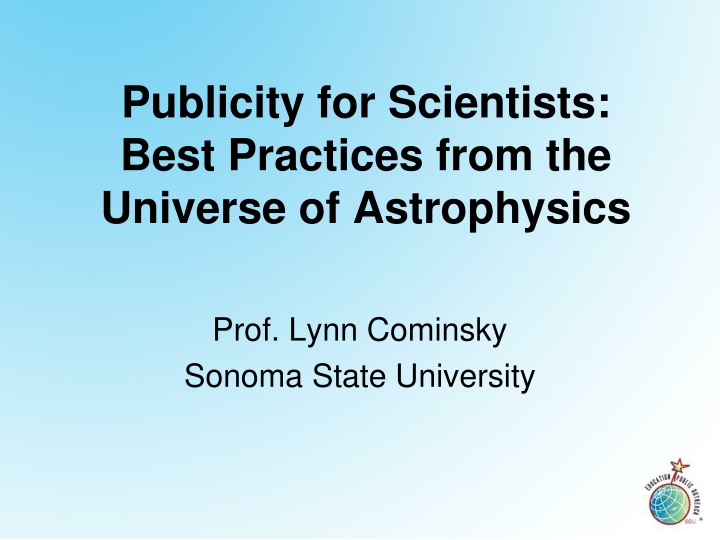
Effective Publicity Strategies for Scientists: Insights from Astrophysics
Learn valuable insights on effective publicity strategies for scientists in the realm of astrophysics. Discover best practices, personal experiences, press activities, newsworthiness criteria, and tips on gaining media coverage in the scientific community.
Download Presentation

Please find below an Image/Link to download the presentation.
The content on the website is provided AS IS for your information and personal use only. It may not be sold, licensed, or shared on other websites without obtaining consent from the author. If you encounter any issues during the download, it is possible that the publisher has removed the file from their server.
You are allowed to download the files provided on this website for personal or commercial use, subject to the condition that they are used lawfully. All files are the property of their respective owners.
The content on the website is provided AS IS for your information and personal use only. It may not be sold, licensed, or shared on other websites without obtaining consent from the author.
E N D
Presentation Transcript
Publicity for Scientists: Best Practices from the Universe of Astrophysics Prof. Lynn Cominsky Sonoma State University
Outline Personal background Publicity for science The importance of graphics Transitions 1
My experience Since 1996 I have been involved in press activities for astrophysics First press officer for AAS/HEAD (5 years) Deputy press officer for AAS (10 years) Press officer for Swift and Fermi ongoing Supported launch for both Swift and Fermi in KSC newsroom Judge for HEAD Schramm journalism award Social media (Twitter and Facebook)
Press Activities Selecting stories for press releases and briefings Working with authors to create presentations and rehearsing for press conferences Working with science writers to create press releases Working with graphics artists on animations and illustrations Organizing and moderating press briefings Explaining results to reporters and providing quotes to the media as commentator
Newsworthiness News must be NEW Can t appear in press prior to official release This includes arXiV, and online journals News must have public appeal Why should the public care? What is exciting about the result? Extremes biggest/smallest, brightest, fastest Unexpected disagrees with current theories Mysteries and danger
News is not like Science Press releases, briefing presentations and news articles are all written in the reverse Lede is first a one sentence summary of the most exciting aspect of the story (what) Details of the discovery methodology Who, how, where, when Quotes about the importance from scientists and outside experts Background information
Getting coverage Decision making: Scientists pitch science to reporters Reporters pitch stories to editors Editors are gatekeepers Decide placement Write headlines Some topics are already public-friendly Black holes Einstein
Dissemination choices Televised press conference rare Media telecons typical Slides online via web conferencing tools Press briefings at professional meetings Paper presented at meeting, not necessarily accepted for publication Electronic press release distribution AAS but also Eurekalert, Universities, etc. Google hangouts, Reddit AMA, etc.
Good graphics are essential Labeled and unlabeled illustrations Animations (narrated and visual only) NASA s YouTube channel GSFC s SVS repository Expensive! ($5-10K for 30 seconds) B-roll for truly major stories (TV-worthy) Background images of instruments, detectors Can include short talking head spots
Press officers are not reviewers Scientists need to decide if and when to seek publicity for their work Press releases do not cite references to prior work Many collaborations insist on an accepted journal paper prior to seeking PR Too late! Good graphics take weeks Need to start PR prep no later than paper submission date
Evolving Media World Newspapers, magazines and wire services used to have dedicated science reporters Now few remain Print media also online Social media and bloggers 24-hour news cycle Graphics are even more important!
Case Study 6th International Fermi symposium in DC Media telecon about 1st gamma-ray pulsar outside the Milky Way on 11/12/15 Media notices T 4 weeks: General invite to reporters (me) T 1 week: Specifics of press briefing (me) T 2 days: Reporters provided with onsite location and GoToMeeting info (me)
Case Study (Other activities) Paper submitted to Science 9/25/15 (scientists) Paper accepted by Science 10/10/15 (approx) Embargo date discussion 10/13/15 (T 4 weeks) (scientists, GSFC and me) T 4 weeks: Video and graphics started (GSFC) T 2 weeks: Draft of press release started (GSFC) T 1.5 weeks: Review first draft of slides and press release (scientists, GSFC and me) T 1 week: Release sent to HQ for approval (GSFC) T 1 week: Find independent commentator (me) T 1 day: Final slide review and rehearsal (me)
Briefing Day 11/12/15 Moderated press conference when Science embargo lifted at 2 pm (me) NASA release sent out electronically (HQ) Social media postings on Twitter and Facebook following official release (outreach person at Sonoma State) Video posted on NASA YouTube channel (>38K views to date) and GSFC SVS (GSFC) Coordinated follow-up queries by reporters (me)
Resources: Marketing for Scientists Facebook group, website and book by Marc Kuchner http://marketingforscientists.com Don t be Such a Scientist book and website by Randy Olson http://dontbesuchascientist.com Master the Media - Book and website by George Merlis http://masterthemedia.com GSFC SVS: http://svs.gsfc.nasa.gov Fermi press: http://www.nasa.gov/fermi/ 15
